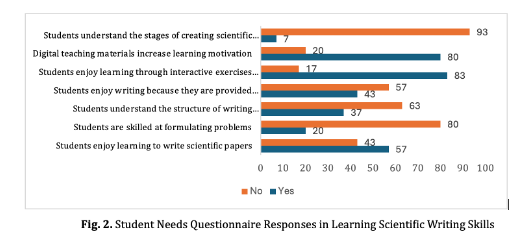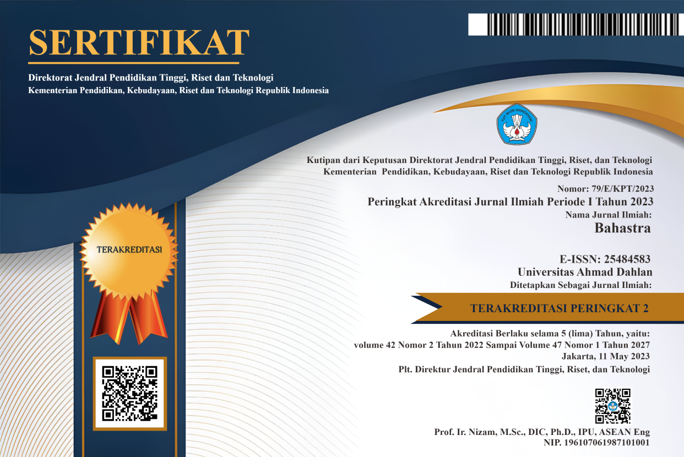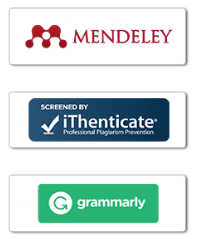Needs analysis fo the development of web-based teaching materials in scientific writing skills instruction for eleventh-grade vocational high school students
DOI:
https://doi.org/10.26555/bs.v45i2.1407Keywords:
Education , Scientific Writing , Teaching Materials , Vocational , Web-BasedAbstract
The development of students' scientific writing skills remains a significant challenge in vocational high schools, where conventional teaching materials often fail to accommodate students' technological learning preferences. This study aims to analyze the needs for developing web-based teaching materials to enhance the scientific writing skills of eleventh-grade vocational students. Utilizing a Research and Development (R&D) approach with the ADDIE model framework, this study involved two vocational school teachers and sixty eleventh-grade students in Bandung, Indonesia. Data were collected through teacher interviews and student questionnaires, then analyzed descriptively. The findings revealed that 63% of students experienced difficulties in scientific writing due to limited understanding of formal writing techniques, structuring arguments, and lack of digital learning resources. Teachers indicated the necessity for contextualized and interactive web-based learning platforms that align with the differentiated learning approach of the Curriculum Merdeka. Furthermore, over 80% of students expressed a preference for digital and interactive learning environments to improve their engagement and writing competence. The study concludes that the development of web-based portable-E teaching materials is essential to bridge the gap between students' needs and current teaching practices. The proposed innovation not only addresses students' difficulties in writing but also promotes independent learning, enhances digital literacy, and supports the achievement of curriculum goals. These findings offer valuable insights for future instructional material design and educational technology integration in vocational education contexts.References
Abuhassna, H., Alnawajha, S., Awae, F., Adnan, M., & Edwards, B. I. (2024). Synthesizing technology integration within the Addie model for instructional design: A comprehensive systematic literature review. Journal of Autonomous Intelligence, 7(5), 1–28. https://doi.org/10.32629/jai.v7i5.1546
Akintayo, O. T., Eden, C. A., Ayeni, O. O., & Onyebuchi, N. C. (2024). Evaluating the impact of educational technology on learning outcomes in the higher education sector: A systematic review. Open Access Research Journal of Multidisciplinary Studies, 7(2), 052–072. https://doi.org/10.53022/oarjms.2024.7.2.0026
Alfianika, N., Sunendar, D., Sastromiharjo, A., & Damaianti, V. S. (2019). Needs analysis: Students’ university learning in writing scientific papers. Journal for the Education of Gifted Young Scientists, 7(4), 915–929. https://doi.org/10.17478/jegys.624050
Anggara, M. R., Purnama, W., & Kuswardhana, D. (2021). Development of scientific writing guidelines for project based learning in vocational school. Proceedings of the 6th UPI International Conference on TVET 2020, 176–180. https://doi.org/10.2991/assehr.k.210203.112
Bellhäuser, H., Liborius, P., & Schmitz, B. (2022). Fostering self-regulated learning in online environments: Positive effects of a web-based training with peer feedback on learning behavior. Frontiers in Psychology, 13. https://doi.org/10.3389/fpsyg.2022.813381
Best, E. (2024). Teachers and whole-school literacy in 2023. National Literacy Trust.
Branch, R. M. (2009). Approach, instructional design: The ADDIE. Statistical Field Theor, 53(9). https://doi.org/10.1007/978-0-387-09506-6
Braun, V., & Clarke, V. (2023). Toward good practice in thematic analysis: Avoiding common problems and be (com) ing a knowing researcher. International Journal of Transgender Health, 24(1), 1–6. https://doi.org/10.1080/26895269.2022.2129597
___________. (2024). Thematic analysis. Encyclopedia of quality of life and well-being research. Springer. https://doi.org/10.4324/9781003362715-21
Challob, A. I., Bakar, N. A., & Latif, H. (2016). Collaborative blended learning writing environment: Effects on EFL students’ writing apprehension and writing performance. English Language Teaching, 9(6), 229–241. https://doi.org/10.5539/elt.v9n6p229
Cohen, L., Manion, L., & Morrison, K. (2018). Research methods in education (8th ed.). Routledge. https://doi.org/10.4324/9781315456539
Creswell, J. W., & Creswell, J. D. (2018). Research design: Qualitative, quantitative, and mixed methods approaches (Fifth Edit). SAGE Publications.
Dayu, D. P. K., & Aprilia, S. (2022). Mind mapping based joyfull learning to increase writing skill. Al-Bidayah: Jurnal Pendidikan Dasar Islam, 14(1), 37–50. https://doi.org/10.14421/al-bidayah.v14i1.744
Dembo, M. H., Gubler, J. L., & Lynch, R. (2013). Becoming a self-regulated learner: Implications for web-based education. Web-Based Learning. Routledge.
Dos Santos, S. C., Vilela, J., & Vasconcelos, A. (2023). Promoting professional competencies through interdisciplinary pbl: An experience report in computing higher education. 2023 IEEE Frontiers in Education Conference (FIE), 1–9. https://doi.org/10.1109/FIE58773.2023.10343050
Ebadi, S., & Rahimi, M. (2017). Exploring the impact of online peer-editing using Google Docs on EFL learners’ academic writing skills: A mixed methods study. Computer Assisted Language Learning, 30(8), 787–815. https://doi.org/10.1080/09588221.2017.1363056
Fauzan, Eriyanti, R. W., Ardianto, F., & Asih, R. A. (2022). A web-based learning media ruang ekspresi to teach poetry writing for junior high school students. Eurasian Journal of Applied Linguistics, 8(2), 202–209. https://doi.org/10.32601/ejal.911553
Franconeri, S. L., Padilla, L. M., Shah, P., Zacks, J. M., & Hullman, J. (2021). The science of visual data communication: What works. Psychological Science in the Public Interest, 22(3), 110–161. https://doi.org/10.1177/15291006211051956
Ghufron, M. A., Saleh, M., Warsono, ., & Sofwan, A. (2016). A model of research paper writing instructional materials for academic writing course: Needs & documents analysis and model design. English Language Teaching, 9(3). https://doi.org/10.5539/elt.v9n3p1
Hadi, A., Marniati, M., Ngindana, R., Kurdi, M. S., Kurdi, M. S., & Fauziah, F. (2023). New paradigm of merdeka belajar curriculum in schools. AL-ISHLAH: Jurnal Pendidikan, 15(2), 1497–1510. https://doi.org/10.35445/alishlah.v15i2.3126
Hasanudin, C., Azizah, A., Fitrianingsih, A., Fitriyana, N., & Saadoon, A. (2024). The effectiveness of mobile-based teaching materials for academic writing in hybrid learning on students’ academic writing ability. Bahastra, 44(1), 16–28. https://doi.org/10.26555/bs.v44i1.635
Hernawan, H., Anshari, D., Syihabuddin, S., & Mulyati, Y. (2023). Exploring the profile of scientific article writing ability among tertiary students: Insights from five institutions in Indonesia. International Journal of Education, 16(2), 157–166. https://doi.org/10.17509/ije.v16i2.57357
Li, J., & Mak, L. (2022). The effects of using an online collaboration tool on college students’ learning of academic writing skills. System, 105, 102712. https://doi.org/10.1016/j.system.2021.102712
Mayer, C., Masser, D., & Remidez, H. (2021). Description of a web-driven, problem-based learning environment and study of the efficacy of implementation in educational leader preparation. The Web in Higher Education. CRC Press. https://doi.org/10.1201/9781003063803-15
McKenney, S., & Brand-Gruwel, S. (2023). Roles and competencies of educational design researchers: One framework and seven guidelines. Learning, Design, and Technology: An International Compendium of Theory, Research, Practice, and Policy. Springer. https://doi.org/10.1007/978-3-319-17461-7_123
Meiliyana, A., & Hikmat, A. (2022). Pengaruh pendekatan contextual teaching and learning (Ctl) terhadap kemampuan menulis puisi pada siswa kelas iv sekolah dasar. Jurnal Cakrawala Pendas, 8(4), 1047–1055. https://doi.org/10.31949/jcp.v8i4.2816
Messer, M., Brown, N. C. C., Kölling, M., & Shi, M. (2024). Automated grading and feedback tools for programming education: A systematic review. ACM Transactions on Computing Education, 24(1). https://doi.org/10.1145/3636515
Miles, M. B., Huberman, A. M., & Saldana, J. (2014). Qualitative data analysis: A methods sourcebook (Third Edit). SAGE Publications.
Mishra, D., & Sain, M. (2021). Web based learning: A methodology to teach literature in a classroom. 2021 23rd International Conference on Advanced Communication Technology (ICACT), 1–7. https://doi.org/10.23919/ICACT51234.2021.9370796
Nisa, K., Ramadhan, S., & Thahar, H. E. (2023). Writing scientific articles for undergraduate students: A need analysis. International Journal of Evaluation and Research in Education, 12(3), 1696–1704. https://doi.org/10.11591/ijere.v12i3.24999
___________. (2022). Student perceptions of technology needs in scientific writing. Proceedings of the 5th International Conference on Language, Literature, and Education (ICLLE-5 2022), 287–295. https://doi.org/10.2991/978-2-494069-85-5
Nurhuda, P., Kaniah, Wahyuni, D., & Harini. (2024). Development of web-based indonesian teaching materials on listening materials for grade x high school level. Studies in Learning and Teaching, 5(1), 30–41. https://doi.org/10.46627/silet.v5i1.349
Patton, M. Q. (2014). Qualitative research & evaluation methods: Integrating theory and practice. Sage publications.
Rashid, T., & Asghar, H. M. (2016). Technology use, self-directed learning, student engagement and academic performance: Examining the interrelations. Computers in Human Behavior, 63, 604–612. https://doi.org/10.1016/j.chb.2016.05.084
Siregar, S. P. E., Sari, F., Sudjoko, S., & Yundayani, A. (2022). Dealing with english writing skills: Through the eyes of vocational students. Eureka: Journal of Educational Research, 1(1), 18–28. https://doi.org/10.56773/ejer.v1i1.3
Sitanggang, E. H., Hasratuddin, H., & Juhana, J. (2023). Pengembangan bahan ajar berbasis model pembelajaran project based learning untuk meningkatkan keterampilan menulis teks prosedur. Jurnal Ilmiah Profesi Pendidikan, 8(3), 1534–1539. https://doi.org/10.29303/jipp.v8i3.1546
Suprihatin, D., Winarni, R., Saddhono, K., & Wardani, N. E. (2021). Scientific approach to promote scientific writing skills using blended learning system. Turkish Journal of Computer and Mathematics Education, 12(13), 762–769. https://www.proquest.com/docview/2623931918/6161911A14E145A6PQ/4?accountid=37408
Susanti, E., Hikmat, A., & Zulaiha, S. (2025). Aplikasi berbasis web dalam pembelajaran menulis teks karya ilmiah: Narrative literature review. Genre, 7(1), 113–122. https://doi.org/10.26555/jg.v7i1.12549
Susilo, J., Kusmana, S., & Anggraeini, R. (2024). The effectiveness of the project-based learning model assisted by audio visual media in writing opinion texts in vocational schools. Bahastra, 42(2), 259–273. https://doi.org/10.26555/bs.v44i2.1043
Terry, G., & Hayfield, N. (2021). Essentials of thematic analysis. American Psychological Association. https://doi.org/10.1037/0000238-000
Ventura, A. C., Scheuer, N., & Pozo, J. I. (2020). Elementary school children’s conceptions of teaching and learning to write as intentional activities. Learning and Instruction, 65, 101249. https://doi.org/10.1016/j.learninstruc.2019.101249
Wagino, W., Maksum, H., Purwanto, W., Simatupang, W., Lapisa, R., & Indrawan, E. (2024). Enhancing learning outcomes and student engagement: Integrating e-learning innovations into problem-based higher education. International Journal of Interactive Mobile Technologies, 18(10). https://doi.org/10.3991/ijim.v18i10.47649
Wilson, J., & Roscoe, R. D. (2020). Automated writing evaluation and feedback: Multiple metrics of efficacy. Journal of Educational Computing Research, 58(1), 87–125. https://doi.org/10.1177/0735633119830764
Yundayani, A., Emzir, E., & Rafli, Z. (2017). Need analysis: The writing skill instructional material context for academic purposes. English Review: Journal of English Education, 6(1), 59–70. https://doi.org/10.25134/erjee.v6i1.771

Downloads
Published
Issue
Section
License
Copyright (c) 2025 Evi Susanti; Ade Hikmat, Wini Tarmini

This work is licensed under a Creative Commons Attribution-ShareAlike 4.0 International License.

1.jpg)






